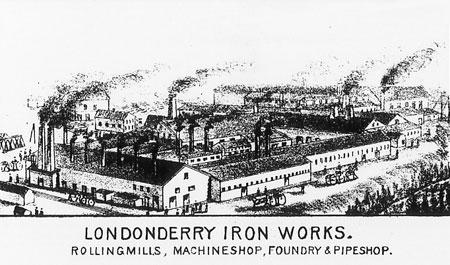We love getting questions about mining, minerals and geology! We were asked about the historical #Londonderry #iron mines. Here's the story...
#nspoli #novascotia #cbpoli @ZannLenore @MunColchester #colchester #nshistory


#nspoli #novascotia #cbpoli @ZannLenore @MunColchester #colchester #nshistory



Iron mining and smelting began in #NovaScotia in 1825 when iron mines opened at Nictaux Falls, #AnnapolisCounty, and the Annapolis Iron Mining Company built a blast furnace at Clementsport between #AnnapolisRoyal and #Digby.
#nspoli #cbpoli #colchester
#nspoli #cbpoli #colchester

Iron has also been mined in numerous other locations in #NovaScotia, including East River, Bridgeville and Stellarton (#PictouCounty), Brookfield and Economy Mountain (#ColchesterCounty), Erinville and other places in #GuysboroughCounty...
#nspoli #cbpoli #colchester
#nspoli #cbpoli #colchester

...Doctors Brook and other places in #AntigonishCounty and in #CapeBreton.
However, all of #NovaScotia’s iron mines were relatively small-scale except for those in Londonderry, #ColchesterCounty, where mining started in 1849.
#nspoli #cbpoli #colchester
However, all of #NovaScotia’s iron mines were relatively small-scale except for those in Londonderry, #ColchesterCounty, where mining started in 1849.
#nspoli #cbpoli #colchester

The Acadian Iron Mines at #Londonderry became the biggest iron producer in Canada. Londonderry produced high quality iron and had a very good reputation.
#nspoli #novascotia #cbpoli #colchester
#nspoli #novascotia #cbpoli #colchester

Its iron was used by the steel mills in Sheffield, England, which only accepted high quality pig iron and produced some of the best steel globally.
#nspoli #novascotia #cbpoli #colchester
#nspoli #novascotia #cbpoli #colchester

According to @HistoricNS, the pig iron produced in #Londonderry was transported by ox cart or horse to Great Village and loaded on to ships. Once the railway was complete in 1858, ore was also shipped by train to #Halifax.
#nspoli #novascotia #cbpoli #colchester
#nspoli #novascotia #cbpoli #colchester

In 1870, #Londonderry’s first steel plant was built and in 1874 the first commercial-scale experiments in making steel using open hearth furnaces took place in Londonderry.
#nspoli #novascotia #cbpoli #colchester
#nspoli #novascotia #cbpoli #colchester

German-British engineer Charles William Siemens’ open hearth furnaces could produce and sustain much higher temperatures than any other furnace, and they became the predominant method of steel-making for many decades.
#nspoli #novascotia #cbpoli #colchester
#nspoli #novascotia #cbpoli #colchester

In 1877 the plant switched from using charcoal as fuel to coke. Beehive-shaped coke ovens were installed to produce coke from coal. Tracks were laid across the top of the ovens, and small coal cars filled each oven through its “charging hole” on top.
#nspoli #novascotia #cbpoli
#nspoli #novascotia #cbpoli

That same year the properties were bought by the Steel Company of Canada.
In the 1890s, as #Londonderry’s iron deposits were gradually depleted, iron ore from the Nictaux-Torbrook area was mixed with ore from Londonderry to stretch the Londonderry supply.
#nspoli #novascotia
In the 1890s, as #Londonderry’s iron deposits were gradually depleted, iron ore from the Nictaux-Torbrook area was mixed with ore from Londonderry to stretch the Londonderry supply.
#nspoli #novascotia

Unfortunately, the blending didn’t work. Nictaux-Torbrook’s ore contained high levels of phosphorous and sulphur, which are impurities in steel-making, and it lowered the quality of the #Londonderry ore.
#nspoli #novascotia #cbpoli #colchester
#nspoli #novascotia #cbpoli #colchester

Operations shut down in 1899 but were started up again in 1904 after the #Londonderry Iron and Mining Company bought the property. However, they shut down again in 1908, permanently this time.
#nspoli #novascotia #cbpoli #colchester
#nspoli #novascotia #cbpoli #colchester

A 1920 fire that destroyed 54 buildings in Londonderry dashed any hopes of restarting operations.
There were three main areas mined in #Londonderry:
The Old Mountain Mine was an underground operation with four main levels.
#nspoli #novascotia #cbpoli #colchester
There were three main areas mined in #Londonderry:
The Old Mountain Mine was an underground operation with four main levels.
#nspoli #novascotia #cbpoli #colchester

The mine was on the west bank of Great Village River about 3000 feet north of the bridge on Base Line Road. There were also some workings at Cook Brook.
The West Mines were between Cumberland Brook and Martin Brook.
#nspoli #novascotia #cbpoli #colchester
The West Mines were between Cumberland Brook and Martin Brook.
#nspoli #novascotia #cbpoli #colchester

The East Mines were between Slack Brook and Gory Brook and saw a mix of underground and surface mining. There were also workings at Weatherbe Brook, Pine Hill Brook and Totten Meadow. The East Mines were mined in the 1890s as #Londonderry was winding down.
#nspoli #novascotia
#nspoli #novascotia

The best ore in Londonderry was called “bottle ore” by the miners. The actual term was botryoidal hematite but the early miners had trouble pronouncing “botryoidal” and shortened it to “bottle.”
It was common for historical miners, most of whom would have been uneducated...
It was common for historical miners, most of whom would have been uneducated...

...to mispronounce technical terms or to invent terms to describe what they saw. For example, gold miners in Waverley used the term “barrel quartz” for folded, gold-bearing quartz veins whose outcrops were corrugated and resembled barrels.
#nspoli #novascotia #cbpoli #colchester
#nspoli #novascotia #cbpoli #colchester

Nova Scotia got into steel production in the 1800s because it has vast coal deposits and the hope was that local iron would provide the second of the two key ingredients. (Steel is mainly iron and carbon, and the carbon is derived from coal.)
#nspoli #cbpoli #colchester
#nspoli #cbpoli #colchester

With the exception of Londonderry, which produced high quality iron until its deposits were largely depleted, most steel production in #NovaScotia used iron from outside the province, mainly from Bell Island, Newfoundland, and also from the Lake Superior region.
#nspoli
#nspoli

#Londonderry was a major industrial centre with iron mining, smelting and steel-making. It had almost 5000 residents at its peak and was the main economic driver in northern #NovaScotia for many years.
#nspoli #cbpoli #colchester


#nspoli #cbpoli #colchester



• • •
Missing some Tweet in this thread? You can try to
force a refresh



























